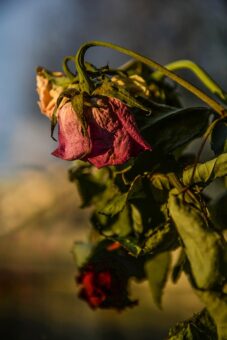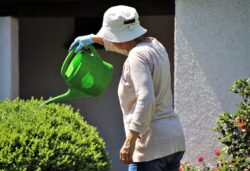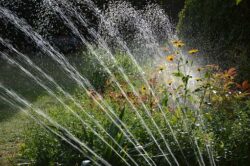In this article, we will discuss the right way to water your containers. In a past article, I have talked about watering but now I want to go onto this in greater depth, so you know how to water your container plant right.
This is so important, as in summer you often see plants in containers die of over or under-watering. It is a shame when this happens, but it can be easily avoided.

When we get a prolonged dry spell in the UK, which is not as rare as people think. It can have a pronounced effect on your container garden. A prolong dry periods as defined by the Metoffice is when you get 10 days or more without rainfall. On average the UK get 133 days of rain and about 885mm of rainfall, which make watering less of a chore.
The crime that is often committed is the way most people treat their plants during a prolonged dry spell, which is so wrong. What most people do is wait until the plants start to wilt and then go round the garden, panicking with a watering can or hose and then sprinkle the container or ground with small amounts of water, every day or two.
This takes a lot of effort and you often get bored. I have never met anybody who likes to water every day. It is time-consuming but worst it can do more harm than good.
THE TWO BASIC ERRORS
There are 2 basic errors as gardeners make. We water everything including the lawn, which can take a lack of water well and will slowly recover once it rains again, instead of concentrating on those expensive or high-risk plants that can be lost. The second basic error is that the gardener applies too little water too frequently.

To avoid these errors, you have to get to know the plants and to know which must be kept watered in a dry spell. Some flowering perennials can tolerate dryness well. Plants such as Acanthus, Achillea, Bergenia, Centaurea, Euphorbia, Geranium. Kniphofia, Nepeta, Phlox, Saliva and Sedums will do well.
In terms of annuals, there are some that average better and will tolerate dry conditions better than others. These are Alyssum, Arctotis, Calendula, Cosmos, Dimorphotheca, Helichrysum, Nasturtium, Portulaca, Tagetes and Zinnias.
THE PLANTS NEED TO ESTABLISH QUICKLY TO SURVIVE DROUGHT
What must be noted that these plants, both annuals and perennials, need to be established to withstand dry conditions better. The plants need water to establish, which can take some time to do, and so until they do, water must be added at regular intervals. High-risk plants include all bedding plants which can take 6 weeks after planting to establish, whilst perennials can take up to a year.
In a hot, dry summer and terms of drought, you must concentrate you watering on these high-risk annuals and perennials, especially if you do not have the time to water everything.

This is especially true in containers as they will dry very quickly. This is why you should concentrate on these first, as they will need the most water and the most looking after.
The first rule must be to concentrate your watering activity on the plants that need it the most. So concentrate on container plants and thirsty plants. The second rule is when you water make sure you do it properly. To give an idea of how much water is lost in an average week in summer, it is estimated that 11 litres of water per square metre will evaporate, which is equivalent to 10ml of rain required to replenish it.
WATER BEFORE THE RESERVES RUN OUT
If there is no rain in the forecast and you have not watered, it will come from the reserves in the soil, which in containers may not be a lot.
Once the reserves are used up, the plants will start to wilt and suffer. The basic principles are to water early, to apply an adequate amount of water and then water again in a few days in a container, or 7 days later in the garden.
THE FOUR STEPS TO WATERING SUCCESS
What are the 4 steps to get watering success?
DO NOT WAIT FOR THE PLANTS TO WILT
The time to water is when the soil at the depth of 5cm below the surface feels dry. Stick your finger to the first knuckle and if it feels dry and the leaves look lacklustre, then it is time to water. In containers, water will be retained more if you use a water-retaining gel premixed with compost before the plants are planted. On sandy soil in the garden, it will dry much quicker and conversely in a heavy, clay soil, less watering is required.
WATER THROUGHLY
Once you have decided that water is required, make sure it is done thoroughly. In containers do so until water appears at the drainage holes. Applying a small amount every few days will encourage the formation of surface roots and for weed seeds to germinate.
USE THE RIGHT TECHNIQUE
There are two main methods to use; point watering and overall watering. Point watering calls for the spout of a watering can be held close to the base of each plant and then adding water gently to soak the area around the root zone.

For watering troughs, raised beds, containers, window boxes and hanging baskets, it is the preferred option. The only major drawback is that it is time-consuming, especially if you have a lot of containers or that you need to cover a very large area. In this case, it is best to use overall watering, especially for large beds and borders. This is when water is applied indiscriminately to the whole area rather than watering each plant individually.
HOSEPIPE OR IRRIGATION?
The usual procedure is to walk around with a hosepipe fitted with a suitable nozzle gun that often comes with 7 to 10 settings (you can find my review of expandable hose here). This boring job can lead to errors, as we tend to move too quickly to get the job done so that the plants receive very little water. You will also feel that you waste a lot of water on the pathways and driveways.
To get over this, you can use a sprinkler, which can be moved along the border or amongst your containers, it feels more satisfactory and much less boring. It is best to use a sprinkler in the evening when the sun is shining. If you are trying to conserve water and time, trickling irrigation systems are preferred, even if you have a lot of containers to water (see my review on irrigation system).
REPEAT IF NECESSARY
Water once more if rain does not fall but at the same time do not overwater as this can lead to stem or root rots. There must be a period of drying out between waterings, which is difficult to do if it is constantly raining.
As a general rule, you need to water containers daily in very hot weather and every 3 days otherwise if no rainfall has fallen.
In the garden, in borders and beds, you may not need to water until 7 days have passed. The precise time to water is so dependent on so many factors, the plant in question, the prevailing weather and soil types. To check if water is required once more examine the soil or compost and if 5cm below the surface feels dry then water immediately. If you do not want to get your finger dirty, you can use moisture meters, which tend to be more precise.
CONCLUSIONS
In this article, we have discussed the right way to water container plants and in the garden in general. As you probably realise is that you have not been doing it right, either watering too little or too often. It is better to water thoroughly until it appears at the drainage holes. If you can afford it, it is better to use an irrigation system on a timer, so the plants get the water when they need it the most.
Check if the plants need water and do not do it routinely, which can be detrimental to the plants. Water when the plant seems and feel dry by either using an expandable hose or a timed, irrigation system. This will save a lot of time and effort.
If you have any questions or comments that you wish to raise about this article, please do so in the comment box below.
Happy watering.

This is very useful information on water plants that you have growing in pots. My daughter grows all her plants in pots and waits until they wilt to water and then wants to know why they look dead. I will be sharing this article with my daughter so she can learn to water her plants properly.
Hi Jannette
That is very much appreciated, as we are never too young or old to learn something new. i hope she gets a lot out of this article.
Kind regards
Antonio
Hello there, thanks for sharing this awesome article I know it would be of great help to the public as it has been to me. I really have been doing a bad job in my garden for a while now. I have already saved this post so I can carefully understand the tips you have given here and apply it to my plants. Thanks!
Hi Ismeglamour
It is frustrating when you buy an expensive plant and then you do not water it correctly, as this can cause the plant to die due to a lack of water or worse you can overwater it and cause root rots to develop. It is important that you develop the right techniques and method to water. It saves a lot of heartaches.
Thanks
Antonio
More than often times, people tend to do the very minute things the very wrong ways because they feel they have the knowleged whereas, they do not have the basic knowledge to actually get things over the line. What you have shared here is very welcomed and I will definitely look into it henceforth for mysefl and my container plants. Thanks so much for sharing here
Hi Kimberly
Thank you for once again stopping by and commenting as it is very much appreciated. it is often that people get the basics wrong and wonder why their plants are not doing well. If you get the watering wrong your plant will either die of thirsty or get waterlogged, neither which is desired. If you follow my tips you will just be watering right?
Thanks
Antonio